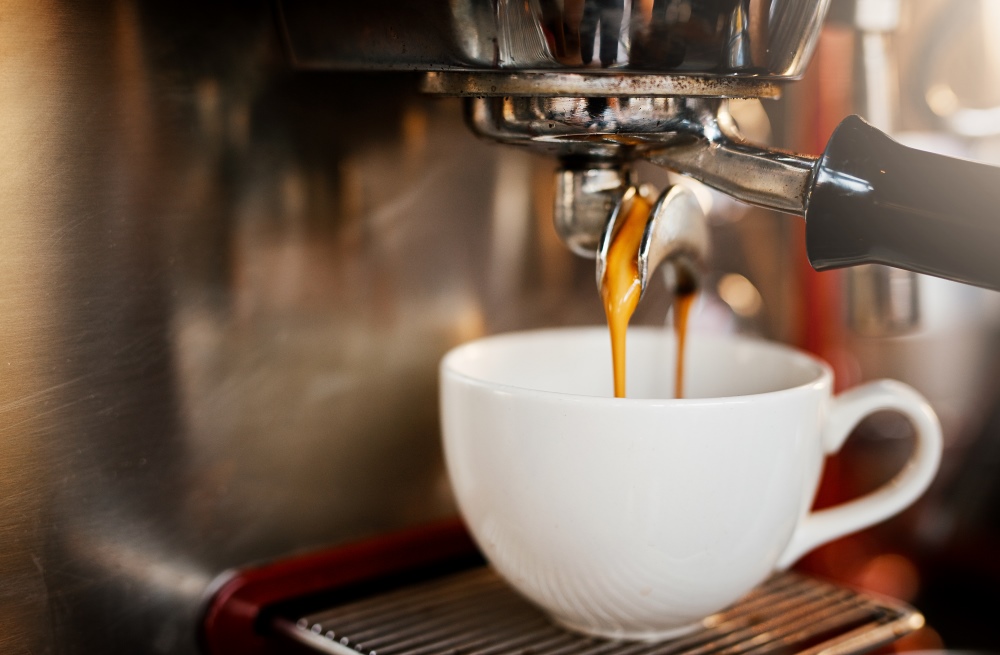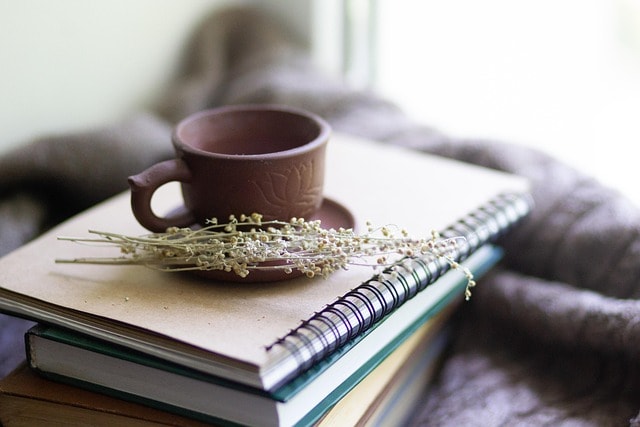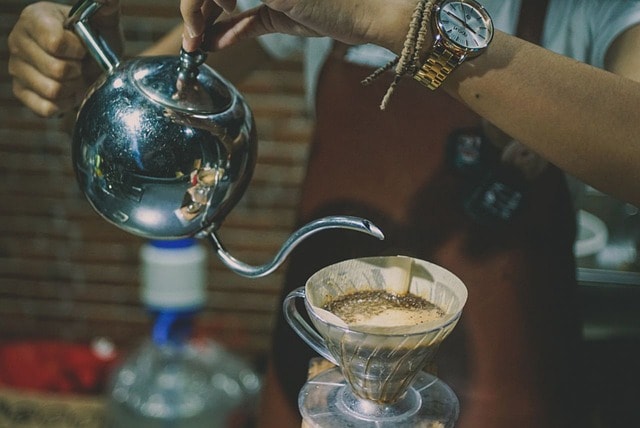At Cooper’s Cask Coffee, we love pretty much all things gourmet-bean-related. That’s why we started a company that’s so meticulous about single origin coffees, roasting processes, and even creating unique barrel aged coffees that have aficionados raving. Well, raving when they’re not sipping.
But who’s the coolest grand-daddy of coffee drinks? Espresso. It’s known around the world, made many ways, brewed by James Bond (poorly, but yeah, he does it in a movie), and loved by wide-awake hordes of java enthusiasts.
If you’re wondering how to make an espresso on your own, we’ve got you covered. Contact us for suggestions on which Cooper’s Cask Coffee bean choices are our personal favorite for espresso. Plus, read on for the low-down on the brew-down.
First, a Word About the Word Espresso
Have you ever seen bagged beans labeled “espresso roast?” For the uninitiated, that might spell “tastes like espresso!” because it’s roasted to be espresso.
Sorry to burst your bubble: there is no such thing as “espresso roast.”
Espresso is the way you brew coffee. You could make an espresso with light roasted, blonde coffee beans. You could make it with delicious medium roasted coffee beans. And of course, for the person who likes bold flavors that make your tastebuds glow, a good dark roast could be de premier choix. Yeah, it sounds cooler in French, because French Roast. #CosmopolitanAndStuff
Technically, espresso at its essence is coffee made using a pressurized brewing method, delivering a stronger, richer flavor than “normal” brewed coffee. Also, the beans are usually finely ground, so that the pressurized hot water can extract as much flavor as possible during the very short time it’s in contact with the water.
However, if you want the great taste of espresso without all the pressurized mechanics, that can be done too!
How to Make an Espresso at Home
How do I brew thee? Let me recount the ways.
Technically Correct Espresso Brewing
Making an espresso at home can be done with or without an espresso machine. But if you want technically proper espresso (and most of us coffee snobs do), you’ll need to use a pressurized espresso brewing system, aka an espresso machine.
Espresso makers come in many shapes, sizes, and prices. But they all do the same thing: They brew espresso by forcing pressurized, near-boiling water through tightly packed, finely ground coffee called a “puck.”
The puck sits in a metal filter that is firmly attached to the machine. As the hot water is forced through the puck, it produces a thick, concentrated coffee.
Hello, espresso!
A single shot of espresso usually comes to about an ounce worth of that liquid gold. Don’t let the small size fool you; the flavor is rich, bold, and complex, plus that shot holds about 63 grams of caffeine (if you’re using caffeinated coffee). An ounce of automatic drip brewed coffee holds about 16 to 18 grams of caffeine.
Related topic: the difference between espresso roast and regular roast.
How to Make an Espresso: Electric Espresso Machine
This is by far our favorite way to make an espresso at any time day or night. Why? Because it’s so incredibly easy, and—depending on the machine—it delivers exactly what you want.
One of our favorite models includes a built-in grinder on one side, and the brewer and steam wand on the other side. Like most normal countertop coffee makers, you have to add water to the machine before brewing.
Grinding & Tamping
The grinder hopper sits on top, usually on the left side. You put the beans in there—and if available, set your grind size. Most of the time it’s a fine to very fine grind for maximum extraction.
Depending on the model, you can set the grinder time to put the just-right amount of coffee into the metal portafilter cup. That’s our preference, because you may want to change the strength of your shot. If you’re doing a double-shot, you also might want more coffee grounds in the portafilter.
You put the portafilter into a special holder under the hopper, and then you either press in on the handle or push a button. This produces a mound of finely ground coffee in the portafilter.
A tamper usually comes with a unit. Once your coffee has been ground, you remove the portafilter from under the hopper and press the tamper down on the grounds. This compresses the coffee to slow the speed of the pressurized hot water as it passes through the grounds. This ensures the water does its job of extracting all of the coffee flavor (and caffeine) possible.
Brewing
You’ll put the portafilter under the brewing side, and with a slight turn, firmly clamp it in place. This is important, because the hot water is dispensed under extreme pressure. If the portafilter isn’t clamped tightly in place, it could leak/spew hot water from around the edges or actually blow off of the dispenser.
Hot water is forced through your puck of grounds, and out of the bottom drizzles your espresso and a rich, delicious foam called the “crema.”
Steam/Foam
Now that you have your shot, what do you do with it?
Some coffee enthusiasts just enjoy the robust flavor of the shot itself. However, you’ve got that handy steam wand on the side and usually a dial above it. That dial can let you either dispense steam from the wand, or dispense hot water through a secondary spigot.
The steam wand is most often used to froth milk. Heating milk brings out more of the milk flavor, plus foaming it adds that upper layer of yum to your latte. If you steam/froth your milk this way, you must clean the steam wand well every time.
The hot water dispenser helps you make an Americano. Yes, it’s that simple. An Americano is an espresso with hot water added. It’s named after the tourists who wanted their coffee in other countries toned down a bit. You can guess where those tourists were from.
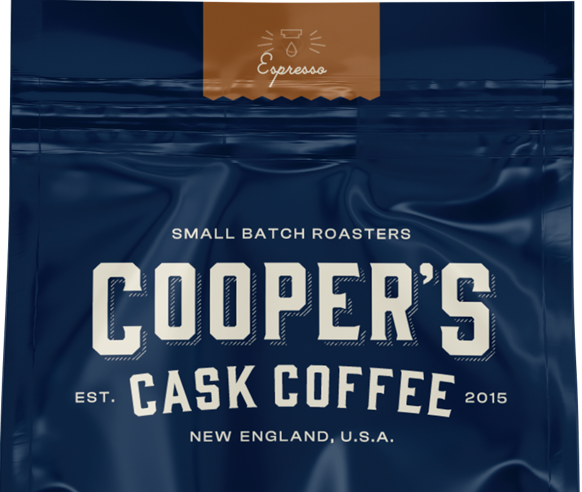
Benefits of an Electric Espresso Machine
- Simplicity
- Convenience
- Quick clean-up
- Control of flavor strength
- Water temperature control
- Ability to set water pressure/extraction time
How to Make an Espresso: Moka Pot
In 1933, a guy named Luigi di Ponti created the Moka Pot, and we love him for it. It’s a simple configuration, requires no electricity, and pressure-brews an amazing coffee that’s espresso-like in flavor.
A Moka Pot consists of 6 parts:
Boiler
This is the bottom part where you add the water.
Safety Valve
This button-like part of the boiler lets out steam if the pressure is too high.
Funnel Tank
This metal part has a tube that goes down into the boiler. Hot water flows upward through it into the grounds.
Rubber Gasket
This sits on top of the funnel tank rim.
Filter Plate
The edge of this small plate rests on the rubber gasket above the coffee grounds. It has many tiny holes through which the espresso moves upwards.
Kettle
This screws down on top of the boiler, pressing down on the filter plate, gasket, and funnel tank to create a tight, leak-proof seal. The kettle has a heat-resistant handle.
Grinding
You’ll need to grind your coffee to medium-fine. It shouldn’t be as fine as regular espresso grind, which takes your beans to the size of table salt.
Fill the funnel tank with your ground coffee—but don’t tamp it. It’s fine to be loose, like how you put coffee into your filter for a pour-over. All that’s needed is for you to level off the coffee grounds so that they’re even in the funnel tank.
Brewing
You start by filling the boiler with the specified amount of hot water. If you use cold water, you’ll end up heating the water and the coffee grounds before the brewing starts. This can make your espresso more bitter. We recommend using a water kettle.
Pour your hot water into the boiler and insert the filled funnel tank. Put the gasket ring on top, the filter plate on top of that, then screw the kettle down to seal it all.
The Moka Pot works on the same principle as a percolator. When you put the Moka Pot on your heat source, the water eventually boils. Because the boiler is sealed by the kettle having been screwed down tightly, the hot water/steam has nowhere to go but up through the stem at the bottom of the funnel tank.
As the hot water/steam passes through the funnel tank, it extracts the flavors and forces the espresso up through the filter. The kettle has a stem built-in to the center of it with an opening at the top. This opening allows the espresso to rise up and dribble down the sides of the stem. Don’t worry, it won’t go shooting straight up. The stem opening is designed to stop that from happening.
When you start to hear a gurgling sound, the boiler is either empty or mostly empty. Take the Moka Pot off the heat source, and put the boiler under the faucet with cool water pouring onto it. This cools down the boiler and stops the pressure.
Depending on the size of the Moka Pot, you’ll end up with 2 ounces (2 shots) of espresso-style coffee. If you get the “2 cup” Moka Pot size, it makes just under 3.5 ounces.
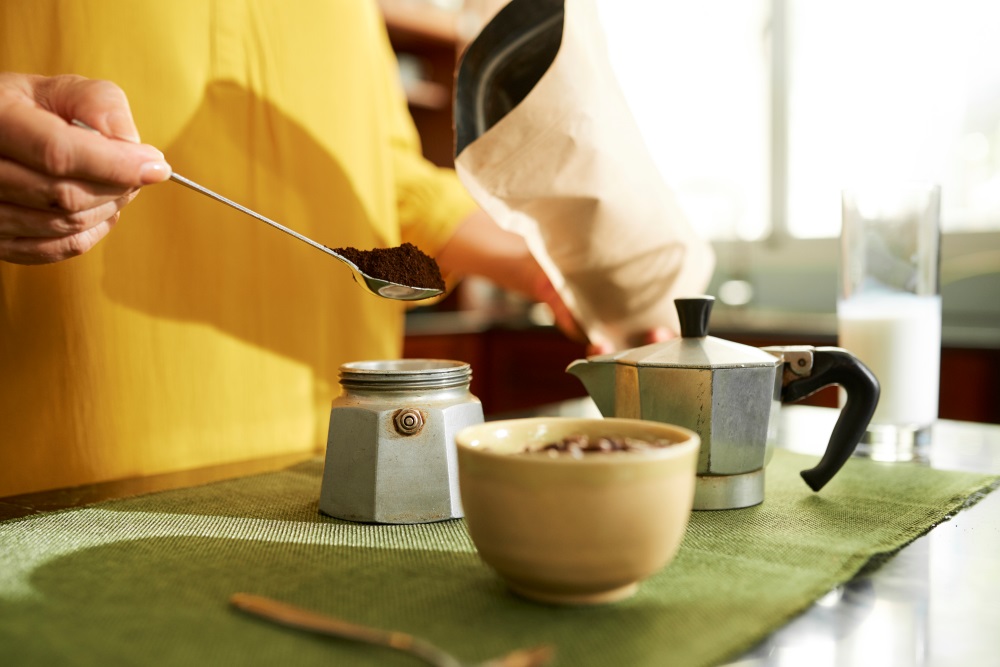
Serving Choices for Moka Pot Espresso
The Moka Pot is an inexpensive middle-ground between a percolator and an espresso machine for how to make an espresso. Unlike a percolator, brewed coffee doesn’t repeatedly enter the heating chamber to be re-forced up through the stem and drizzled onto the grounds.
If you want to add frothed milk, you’ll need an outside device to do that. To match the non-technical aspect of the Moka Pot, we suggest heating milk to an almost-boiling temperature in a small pan. Don’t boil it, as this can cause milk to scald against the pan bottom and add unwanted flavor.
When the milk is almost boiling, pour it into your French press, and use the plunger filter as a “frother” by repeatedly—and quickly—pushing it down and pulling it up. Voila, foamed milk at your service!
If you want to make an Americano, you can add hot water from your external brew kettle.
How to Make an Espresso: AeroPress
This almost seems like a cheat because it’s so fast and easy. However, it makes a great cup of espresso-style coffee!
How does an AeroPress coffee maker work?
The AeroPress brewing system is a 1 or 2 cup pressure-based plunger system for making coffee. It’s 100% manual for brewing. You will need an external grinder and an external water heating source.
If you check out our Cooper’s Cask Coffee gear page, you’ll find excellent and affordable grinders, water kettles, and 2 kinds of AeroPress brewers—a home Aeropress Original Coffee Maker kit and a portable Aeropress Go Travel Coffee Maker.
An AeroPress kit consists of:
- A plunger
- A water chamber
- A filter cap
- Paper filters
- A scoop
- A stirrer
The AeroPress Brewing Process
First, you insert the paper filter into the perforated filter cap. Screw the filter cap onto the bottom of the water chamber. Add the coffee of your choice. For manual brewing like this, we recommend Cooper’s Cask Coffee dark roasts for more authentic, richer flavor.
Put the AeroPress brewer on top of your coffee cup, and make sure it’s stable enough to firmly press down on. Add hot water from your kettle up to the #1 on the side of the AeroPress. Use the paddle to stir the coffee so that the grounds have a chance to bloom and the extraction process begins quickly.
Now, add the rest of your hot water. We recommend only using about 1/2 the hot water you would usually use for a cup of coffee—approximately 1.5 ounces.
Put the plunger into the top of the AeroPress, and press down gently but firmly. The pressure that builds up in the water chamber forces the hot water down through the grounds and into your cup.
Another Way to Use Your AeroPress
If you want your grounds to brew a little longer, you can first add the plunger to the end of the water chamber, making sure it’s sealed. Next, add a paper filter to the filter cap and wet it with some of your hot water—but don’t put it on the AeroPress yet.
Invert the AeroPress so that the plunger is on the bottom. Add your grounds, then add the appropriate amount of water for your desired cup. Use the stir paddle to give it 3 to 5 stirs. Screw on the filter cap, and push the water chamber down onto the plunger until the brewing coffee is close to the filter.
Let the grounds steep for 1 minute, then carefully turn the AeroPress over onto your coffee cup. Press gently down on the plunger, taking around 30 seconds to push all of the coffee through the filter. When you hear a hissing sound toward the end of your plunge step, stop pressing.
You can press more and get a few extra drops forced out, but this last part of liquid in the grinds and the filter can tend to be bitter.
Serving Choices for AeroPress Espresso
The rest is pretty much the same as with the Moka Pot. There is one catch, however: The AeroPress brewing method doesn’t deliver the crema like how to make an espresso with a Moka Pot or an electric espresso machine.
Related topic: ways you can cook with coffee.
How to Make an Espresso: French Press
Our last personally recommended brewing method for brewing espresso is a French press. You won’t have the higher pressures of the previous methods to force the hot water through your filter. However, you will get a delicious and rich cup of espresso-like coffee.
How does a French press coffee maker work?
A French press coffee maker utilizes just a few manually operated parts:
- The beaker/carafe, held in a frame including a handle
- A plunger rod connected to a round plate with a filter screen
- The lid through which the plunger rod slides vertically
As with the other non-electric brewers, you’ll need extra equipment to grind the coffee beans and heat the water. French coffee makers come in several sizes, from practically single-serve to household-sized beakers. We recommend the smaller sizes for espresso making—because a 10-cup beaker of espresso is just strong coffee. It won’t have the thickness or mouthfeel of espresso.
The coffee is made in the beaker by pressing the metal screen filter down through the brewed grinds, leaving behind the coffee for serving.
The French Press Brewing Process
Start your water heating in your kettle. Next, add your coffee grounds to the beaker. We recommend a medium to medium-fine grind. Most French brew is made with a coarse grind, but this is espresso, and you want the maximum amount of extraction.
We also recommend using around twice the amount of grounds than normal for a French roast brew. For maximum flavor, choose medium roast, medium dark roast, or dark roast Cooper’s Cask Coffee.
The French Press Brewing Process
This is the easiest brew process after the electric espresso machine. Start by pouring your coffee into the beaker. Next, pour about half of your hot water into the beaker. Steep the grounds for 1 minute to let them bloom.
Add the rest of the hot water, stir the grounds, and let it steep again for 2 to 3 minutes. You can let it brew longer for more flavor; however, this runs the risk of making the espresso-style coffee bitter.
Put the plunger cap onto the beaker, and slowly press the plunger down. Another difference from regular French press brewing is that, for espresso-style coffee, you stop the plunger halfway down, gently pull it back up, then do a final press all the way down to the bottom. This can create a crema-like foam at the top, though it doesn’t have the richer texture or flavor of true crema.
Pour your espresso-style coffee into a cup and enjoy.
Serving Choices for French Press Espresso
Your additional espresso-style additives work the same as with the other manual espresso makers. You’ll want to serve all of the French press espresso brew at once, though. The longer the brew stays in contact with the grounds at the bottom of the beaker, the larger the chance of over-extraction of that top layer of grounds. This can cause bitterness in the coffee.
Also, the coffee cools fairly quickly in the beaker—so bottoms up!
Choosing the Right Cooper’s Cask Coffee for Espresso
While you’re learning how to make an espresso, the coffee you use makes the difference. The beans need to be fresh for maximum tastiness. As for which coffee to choose, you can contact us and we’ll gladly make recommendations depending on the type of regular coffee you enjoy.
Just keep in mind: Any coffee can be used to make espresso! The brewing style can help you determine which coffee roasts will deliver more flavor in your espresso, but any roast level or bean type will work.
If you prefer light roast (blonde roast) and aren’t a fan of darker roast, we would recommend using an electric espresso machine or a Moka Pot. Beyond that—experiment! The best espresso is the one that you will enjoy.
Will Cooper’s Cask Coffee offer an electric espresso maker soon?
Yes, we are currently in talks with our vendors, and we will soon be offering espresso machines. The reason it has taken this long is because we personally test every single item type that we offer. It has to work excellently for us first before we’ll offer it to our customers.
Our gear page offers a curated list of coffee making items, all curated by us so you get the best of the best, no matter the price.
Exciting Choices to Espresso Yourself
Cooper’s Cask Coffee offers single-original coffees for the most authentic, fresh, and delicious coffee available today. You’ll enjoy the unique terroir from each region, and soon you’ll be able to discern Rwanda single origin coffee from Guatemala single origin coffee just by the taste alone. That will make you a coffee snob. You’re welcome.
Don’t forget our amazing barrel aged coffee bean choices too! From overtones of whiskey, bourbon, and rum, to infused flavors of the world’s most popular wines, you’ll have new and exciting coffee moments to explore.
The Freshest Coffee Possible
The only way you could get fresher coffee is to do it yourself. But to avoid that expensive, painstaking process—we’re there for you.
We don’t start the roasting process until an order is placed, delivering the freshest roast possible. When you order from our website, we even hand-write the roast date on the bag along with the lot number.
Your Espresso Deserves Cooper’s Cask Coffee
You’ll find over 7,000 4- and 5-star Amazon reviews about our products for a reason. We just don’t settle for second best.
Contact us with any questions on how to make an espresso or to find out more about our single origin and barrel aged coffees. A conversation about coffee? We’re in for that!
We always offer a 100% money back guarantee too. If your order doesn’t wholly satisfy you, you can return it for free or exchange it for another delicious roast. No risk, just reward for coffee lovers.
Small batch, big satisfaction. Cooper’s Cask Coffee.

